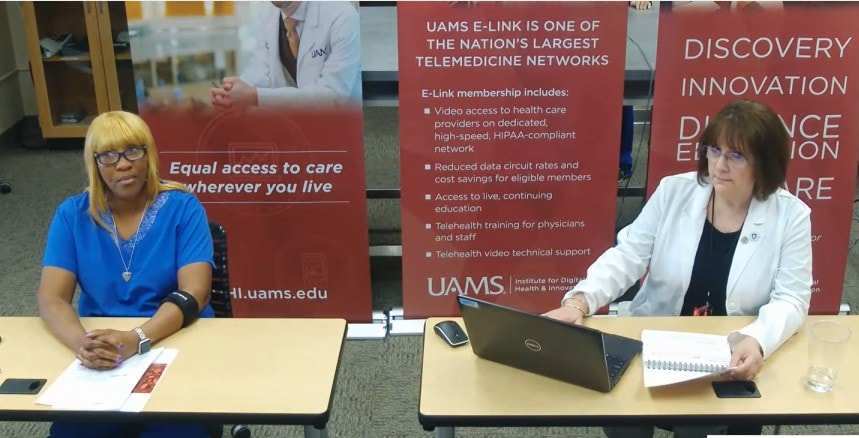Annual Sickle Cell Disease Symposium Highlights Multiple Barriers to Care
| Adult sickle cell patients continue to benefit from increased awareness and newly available therapies. However, lack of research funding and access to care, as well as perceived bias from health care professionals, are still impediments to better care.
That was the message from the annual UAMS Sickle Cell Symposium, held virtually June 10. The symposium was livestreamed to about 20 participants.
Program coordinators Stella Bowers, RN, and Rebecca Camp, APRN, spoke at length about the state of sickle cell disease in Arkansas.
Sickle cell disease is a group of inherited red blood cell disorders. Healthy red blood cells are round and travel through small blood vessels to carry oxygen throughout the body. With sickle cell disease, the red blood cells become hard and sticky, and result in a C-shape or “sickle.” When sickle cells travel to small blood vessels, they get trapped and block blood flow to the area. This results in pain and may lead to other problems such as infection, acute chest syndrome and stroke.
During a pain crisis, sickle cell disease patients often seek immediate treatment for their pain in hospital Emergency Departments, where they are seen by physicians or resident physicians who have little experience treating patients with sickle cell disease.
There are approximately 100,000 Americans affected by sickle cell disease, according to the Centers for Disease Control and Prevention. Sixty percent of those are adults. There are more than 1,000 Arkansans with sickle cell disease, with roughly 20 new cases detected each year.
The overwhelming majority of sickle cell disease patients are Black.
Newborn screenings have helped begin treatment early, but it took many years for them to be put into effect, Camp said. Screenings were developed in 1973 but not used in Arkansas until 1988, and were not universally adopted in the United States until 2006.
“Historically, there have been barriers to care in the sickle cell population,” Camp said.
More treatment options have become available, especially in recent years, but clinicians with experience treating sickle cell remain limited, Camp said. Distance to travel is another issue, including in Arkansas, where the only specialty clinics are in Little Rock.
“There are a significant number of sickle cell patients living 100 miles or more away [from Little Rock],” Camp said. “Patients that we have driving this far seem to have a higher no-show rate and have no choice but to go to their local Emergency Department for a pain crisis.”
Sickle cell patients often need to return after routine follow-ups for testing, imaging or infusions, which means more frequent travel. For patients living far from Little Rock, the process of arriving, receiving treatment and returning home can take up most of a given day.
“It can be extremely hard for these patients to drive long distances for multiple visits in a month, or even in a year due to socioeconomic factors,” Camp said.
The national opioid crisis has brought increases in opioid-use related deaths and added to a hesitancy to prescribe pain medications. Since many sickle cell patients are diagnosed early in life, they become familiar with opioids quickly and are taught to ask for medications that they know have been successful in relieving their pain. Their pain tolerance also tends to be higher, meaning they may not initially appear to be in need of medication. Clinicians in those settings often are skeptical of pain complaints and suspect sickle cell patients are merely seeking drugs.
“Racial bias continues to play a role in patients getting the pain management they require,” Camp said.
The UAMS Adult Sickle Cell Clinical Program launched in 2014. Since then, the program has helped treat hundreds of patients and families. It collaborates with the pediatric Sickle Cell Disease Program at Arkansas Children’s and often receives patients when they age out of the program. Last year, UAMS transferred four patients from Children’s, Camp said. Overall the program maintains more than 250 active patients across the state.
Sickle cell patients need more support going forward, Camp said. Among her recommendations were to increase the availability of stem cell transplants, which are the only known cure for sickle cell disease, and increase support for research and clinical trials. There is also a need to increase access through more informed providers, digital health options and education outreach.
“Even though things are improving, sickle cell disease continues to be understudied and lacks funding in all areas,” Camp said.
The symposium closed with presentations on two recent treatments for sickle cell patients: voxelotor and crizanlizumab. Approved by the FDA in 2019, voxelotor increases hemoglobin, the protein in red blood cells that carries oxygen, to reduce anemia in patients. Crizanlizumab, also FDA-approved in 2019, inhibits platelet aggregation to help keep red blood cells from clumping together.
